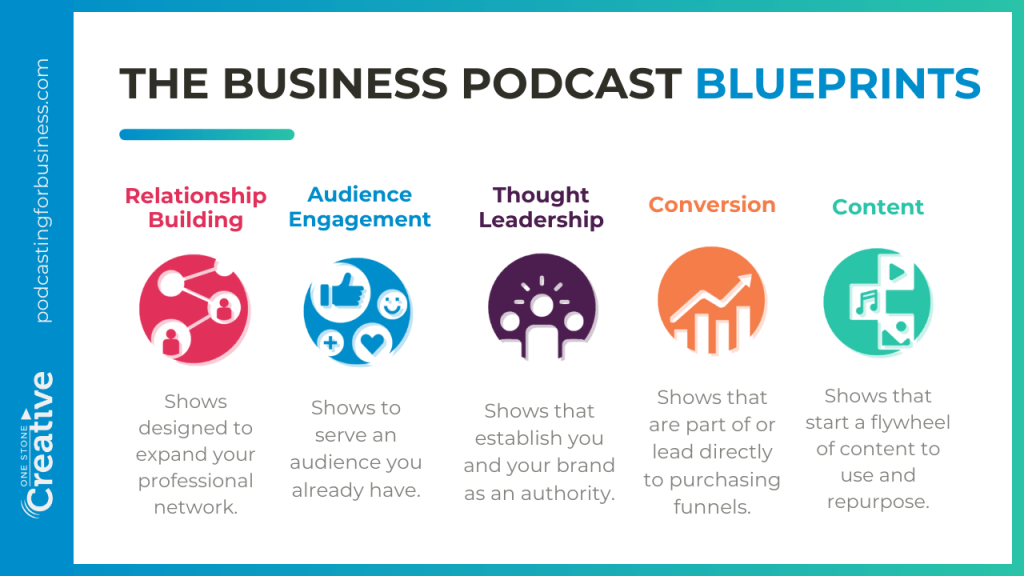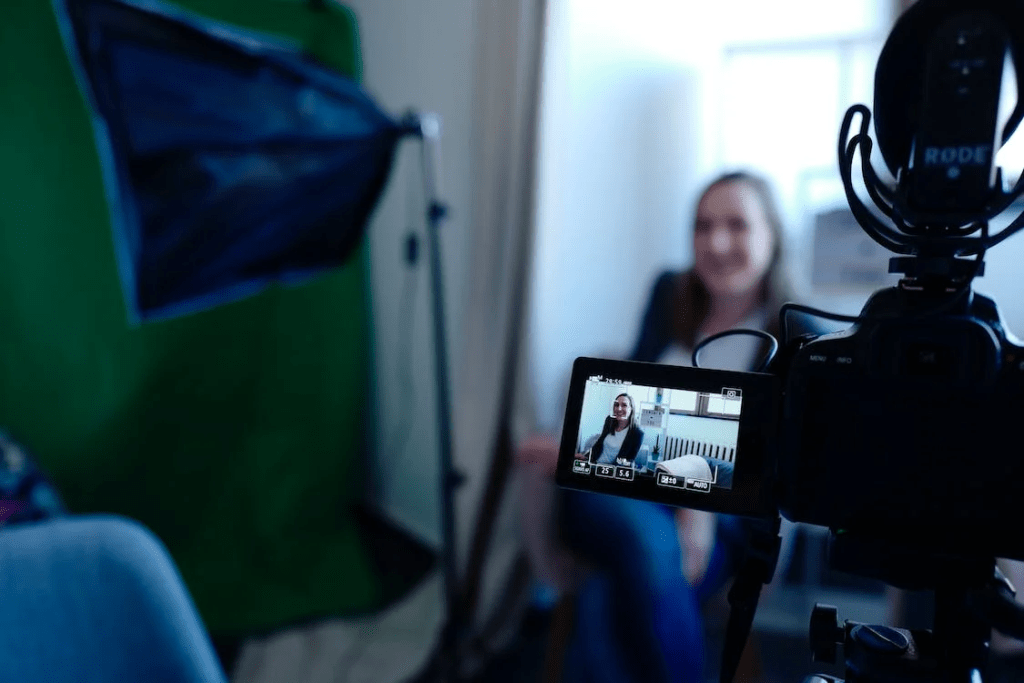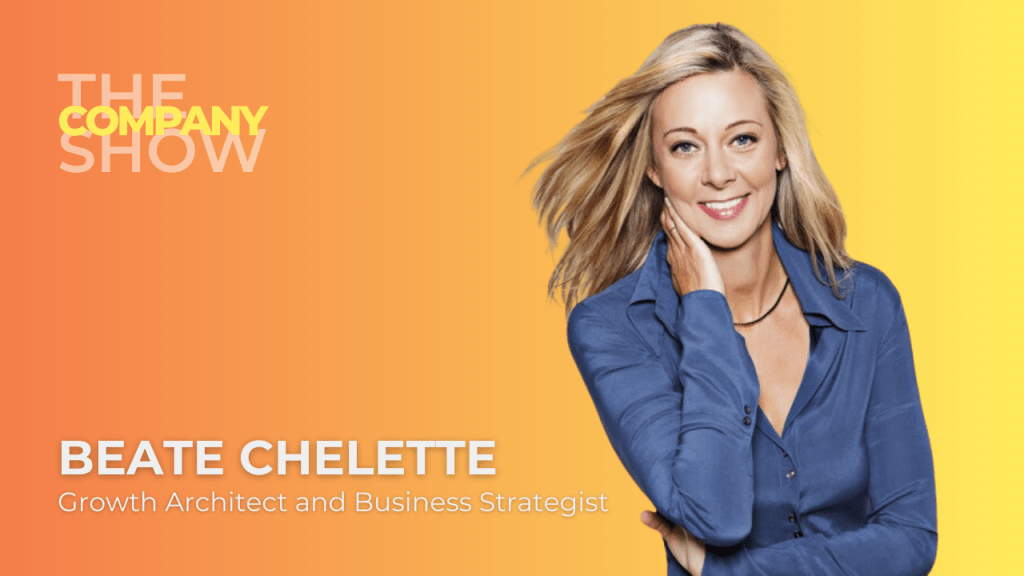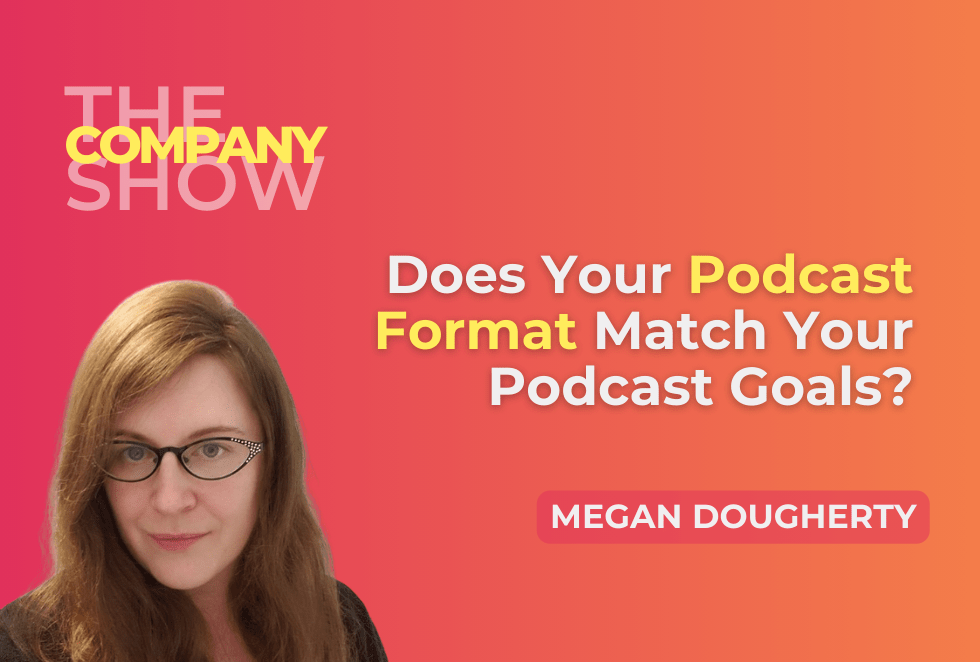Podcasts can come in a lot of different shapes and sizes, and one of the first decisions you need to make as a podcaster is what type of show you want to create.
This is one of the biggest early stumbling blocks company podcasters can run into, and the consequences of making the wrong choice can be severe when it comes to actually getting any value out of the project.
Often, when people think “podcast”, they think: “interview,” but it’s not that clear cut, and selecting the wrong format for your business goals can mean you invest a huge amount of time and resources in something that will be… sort of okay, but maybe not that great. Depending on which of the Blueprints you’re using, and which specific success metrics matter the most to you, not to mention your specific needs around time and budgetary investment, there are styles of show that make more or less sense for your business.
The most important consideration is how well a specific format helps you meet your overarching, and specific podcasting goals.
Creating a show with the wrong format for your goals means you are putting yourself at an immediate disadvantage when it comes to making progress toward your business objectives, and it’s all too common for businesses to put tons of effort into a podcast – and make amazing content- but not see the kind of bottom-line impact they need to justify the work.
We’re going to talk about Interviews, Solo episodes, Co-hosted conversations, Panel Discussions, Demonstrative Shows, Documentary style, Clip Shows, and Lives. There are other formats of course, like narrative, fiction, news, and more – but these are the ones most likely to find a place in podcasts that exist AS businesses, or are passion projects. We’re always balancing the desire to create with the needs of a business, and while quality is always critical, efficiency matters too!
Listen below or continue reading the blog post!
Tune in to the full episode to learn about the different podcast episode formats and when to use them for different business objectives.
8 Types of Podcast Episodes for Different Business Objectives

This is an update to a podcast episode we created back in August of 2022 – we’ve added information about how each of these podcast types can be leveraged within your business according to the Business Podcast Blueprints
So let’s go high level for a moment before we dig into the episode types.
Why is it so important to make a format decision based on your business objectives? Isn’t just creating great content for your audience enough?
It is if you’re in it for the love of the game – but not if you’ve got KPIs to meet, and you want to get the MOST value out of your investment.
Example #1
Let’s say that company A started a podcast because they want to establish their company as a Thought Leader in the industry – their goal is to be seen as a thought leader, and make sure their ideas and IP get out there into the world.
So they start a podcast and they get the highest profile guests they can find to join the host who, naturally, wants them to feel comfortable and highlight their expertise! So the host crafts questions that will let their guests shine and share their knowledge and expertise, and they promote the episodes by saying: look at this awesome conversation we had with this amazing person in the space!
The thought leadership of the guests increases, and the thought leadership of the host company does not exist at all – the podcast is a vehicle for OTHER expert opinions.
And that can be an amazing podcast – but it doesn’t match the goals that Company A has of establishing themselves as thinkers and innovators in their space, and they are instead investing a lot of time, energy, and money promoting the ideas of outside experts.
They would be much better served by creating solo episodes with their own content and ideas, answering questions from the community about their space, or if they do want an interview-style show, focusing on complementary experts with whom they can have a conversation between equals about topics of mutual interest that they can contribute to as much as their guests do. (Also with some solo episodes for good measure!)
Example #2
Company B knows that the most important thing a podcast can do for them is help them increase their professional network – they need more referral and collaboration partners, so they, very sensible, decide to do a relationship-building podcast. Since both time and money are at a premium, they decide they’ll host panel discussions with ideal referral partners from different industries and create some content that will be of real use to their audience.
Again – this can be an excellent show, but because there is so little one-on-one time between the host and each of the guests, the relationship isn’t that strong – probably not strong enough that anyone feels comfortable making a referral for new business. This can be somewhat mitigated by investing a lot of time in prep calls and follow-up… but then any savings in time-spend and cost are eaten up by the extra labor.
Instead, it would be a wiser course of action to settle on a weekly or bi-weekly interview show where the host can spend some real time with each guest, talk to them, get to know them, and plant the seeds of an ongoing relationship – ultimately distributing time and resources that way is going to have a better return on the ultimate goal of getting more referrals.
With all of this in mind – let’s get into the different episode types, and when they are most appropriate. Please keep in mind that while these are rules of thumb – there are always exceptions – and also new ways of leveraging podcasts – people are coming up with new brilliant stuff all the time!
We’re going to cover Interviews, Solo episodes, Co-hosted conversations, Panel Discussions, Demonstrative Shows, Documentary style, Clip Shows, and Lives – let’s begin.
Interviews

Interviews are a hugely popular podcasting format, and with good reason! They’re dynamic, let you network, and help you bring fresh new ideas to your audience. But there are different kinds of interviews. High level, they come in two types: conversational and informational. Conversational interviews are ‘interviews’ that are really conversations between equals when you are using a Thought Leadership Blueprint, and informational interviews are about sharing another person’s expertise with your audience which is the Relationship Building, Content, and Audience Engagement play. They each have their place.
Interviews both informational and conversational can also be part of a **conversion-**style podcast where you’re looking to move people directly from one part of the buyer journey to another perhaps as part of a sales process, and there are good and bad ways to go about it. Using the podcast to try and sell your services to guests is… a tactic some people do choose to use, and let’s leave it at that – there are better ways to use a podcast for conversions, like in demonstrative shows, which can be interviewed as well, or by using the podcast and your recording process as an engagement tool itself – but that’s a topic for another day.
Generally, Unless we’re talking about thought leadership, podcast interviews are usually although not always Informational in nature.
In an informational style interview the focus is really on the guest, and not so much on the host. The host is shining, rather than sharing the spotlight, for the purpose of bringing valuable information to an audience.
These interviews work the best when you know that your audience (or you yourself!) could benefit from information that you don’t necessarily possess yourself or within your company, and when your key goal for podcasting is expanding your own professional network of experts who serve similar audiences.
(Remember, you’re always going to be able to use an interview to network and build relationships – that is always a relationship-building benefit you can get from them!)
Conversational
In a conversational-style podcast, you want to make sure that you and your guest are talking to each other, digging into ideas as they come up, and each contributing your own experience and expertise to the topic at hand. You are not just going to run down a list of prepared questions, and you’re not going to spend the whole conversation getting your guests to talk about what they’re great at – that’s an informational interview.
Conversational interviews are a little tricky – it takes practice to have equal conversations with strangers, but they are brilliant for enhancing your own thought leadership because when you’re talking to another expert it conveys that you have access to experts and are on the same professional level that they are. Of course, this means you need to really curate who you are talking to. This is not the style of a show where you’re going to have a list of questions you want to cover, but rather a subject you and your guest are going to discuss together.
Having conversations with fellow professionals also gives you the chance to build and nurture relationships with them, and explore aspects of your own subject matter in new and interesting ways.
Solo Episodes
Solo episodes are a popular podcast format for Thought Leadership and Audience Engagement podcasts – as well as being a massive boon to the content-motivated among us. They can also contribute to conversion goals, depending on how they are deployed within a buying journey.
In a solo podcast or episode (lots of shows like to mix up interviews and solo content to get benefits from multiple blueprint styles ahem).
Solo shows can either be scripted or off the cuff. Scripted means you plan in advance more or less exactly what you’re going to say and in what order, either with a detailed outline or a full script.
Off the cuff is when you have a key topic, or a brief outline and you just go to town on it.
What you need to watch out for is that reading often sounds like reading and that is unendurably boring to listen to. On the other hand, off-the-cuff can be so scattered that it’s hard to follow. You’ll also be at risk of pressing publish and realizing you’ve left out important details.
Try out a few different methods to see what strikes the best balance for you.
Another issue that people sometimes run into with solo episodes is that when it’s just you and the mic, building the momentum and excitement can be a little challenging. Not to put too fine a point on it: but it’s weird. There is a dynamism to having a conversation with another person that keeps the energy going, and for some hosts – that’s a necessity, not a nice to have. It really comes down to your own skills, style, and preferences.
Some of the different types of solo podcasts are monologues, and Q and A.
Monologues
A monologue-style show can be viewed as an audio essay or blog post. You have your topic, the different points about it that you want to cover – hopefully a few stories and opinions to keep things interesting, and off you go! These are great when you want to talk about things that are going on in your industry, share the results of research or experiments (these are also demonstrative podcasts, in many cases!), provide actionable information, theory, and strategy to your listeners, and generally teach. The key idea is information transfer from the you, the host to the listener, in an efficient, portable way.
Q and A
Another very popular style of solo show is the Q and A format, where the hot answers questions that were either submitted by listeners (and sometimes audio clips of people asking them are included! But not always), or culled from inboxes and social media. These are great for a lot of reasons too.
First and foremost, if one person drums up the courage to actually ASK – you can be reasonably certain a lot of people are wondering, and providing a direct answer is a real service to your community. Secondly, it’s so, so, so repurposable. Massive Q and A lists, multi-media resources for the sales team to distribute, content to put on social, you can use these all over your online presence.
It should also be said that for a lot of experts, answering questions is fun… but can get tedious when it’s the 400th time, so having a definitive answer to a common question to share can save a lot of time.
These shows can also be quite quick to put together. Pick a theme, find a few questions you’ve been asked, read and answer them, and send them to production.
Co-Host Conversations
A co-hosted conversational podcast is exactly what it says on the tin – two hosts talking to each other, and sharing information with the audience. These kinds of shows are often – but not always, really about education – taking subject matter and conveying it to the listener in an organized and enjoyable format.
These shows can be a lot of fun, especially for Audience Engagement and Thought Leadership podcasts, where you have a crowd of engaged audience hungry for more content from your organization. You can fill that need for them, and provide a huge amount of content without the considerable trouble and expense of a guest management process.
Sometimes you will have guests join the co-hosts on a show like this, but from a production standpoint, that can get a little chaotic, not to mention be a little rough on a guest! Two interviewers and one interviewee isn’t the most comfortable situation for most people.
Demonstrative Podcasts
Now, let’s talk about demonstrative podcasts – these are shows that are primarily used to show that you can walk what you talk. Think case studies, live coaching, analysis of events, reviews, and commentary in your industry. These are generally for Audience Engagement or Conversion style shows, and they can be a little more difficult to arrange than a straight interview or solo episode, but they can be enormously valuable for both your audience and your business.
Coaches and consultants can find a lot of value in this style of show, if they have clients willing to be coached on the air, it can be a fabulous way to demonstrate the methodology the coach uses, and the kinds of breakthroughs their clients can see. Again, this helps the listener, by giving them an example to relate to and proof that the service or coaching works, and gives the business a chance to demonstrate the value of the services.
You can also have an interview-style podcast where the host primarily talks to current or past clients about what they achieved together, building a library of very powerful sales tools.
Not every demonstrative podcast needs a direct case study, of course – the goal with these types of podcasts is to show in a very real way that the company knows what it’s talking about, so providing reviews of products, services, books, and other content creators can accomplish eh same goal, and likewise researching, analyzing and communicating news and developments in the industry can have the same impact.
What we’ve covered so far are the main, high-level options for weekly or bi-weekly release schedules – once you get into the swing of things, they’re fairly quick to create, and you can build a solid workflow that meshes seamlessly with the rest of your week. There are a whole bunch of other show formats, of course, that take a little more arrangement on the front end, or more of an investment in post-production, and so aren’t typically great for businesses to do every week, but that can be amazing for a special series, event, or milestones like 100th episodes or book and product launches.
Documentary Style
A documentary-style podcast is one that tells a story with a beginning, middle, and end, either within a single episode or from the beginning of a season or series to the end. Very often these will be more highly produced, with more sound elements than a standard interview or solo show, and as such, they can be a little more challenging and expensive to produce, but the results can be astounding – and generally evergreen!
Sometimes, a single host will provide all of the narrative and information, or there will be a combination of a host providing the framing and context, supplemented by other speakers with personal anecdotes, specialized information, or additional context. There is going to be a lot more planning on the front end for this type of show, which is why you will see it more frequently as a special or a standalone than something that is created every week.
Some business use cases for a documentary-style show could be the origin story of your organization, a series following a client or customer using your product or services, an industry event, or a product, service, or book launch.
Clip Show
A clip show is an episode composed of selections from other episodes, for example, the top 10 lessons from 100 episodes, or the 10 best insights from a year of podcasting. Individual clips from previous episodes will be selected, on a particular theme, then re-edited into a new episode with the host “framing” the clips being presented, providing the context for them, why the clips are important, and what connects them. This means the production process can get a little ungainly, but it can be well, well worth it
We often create clip shows for milestone episodes – they’re a lovely celebration of the work that has come before.
Another benefit of a clip show is being able to amp up promotion! Every guest who is featured in the show can be contacted to say something along the lines of: hey! Your insight about XYZ was so good we included it in this super special clip show! Here’s a link!” As always, not everyone will share, but it’s a very nice email to be able to send from a relationship-building standpoint!
Panel Discussions
A panel discussion show is one where you gather multiple experts on a topic, and moderate a conversation between them. You’ve seen these at conferences, I’m sure! A moderator, the host in this case, will post questions and then get insights from each of the guests. These can be fascinating podcast episodes if a lot of work. They’re enough work that I would not recommend them as a weekly, or even a monthly part of your schedule – just getting that many people on a call at the same time can be a bit of a headache, but they can be a fantastic capstone to a season, a special to promote a major launch or release, a bonus episode or a quarterly event that features largely in your promotions. As with any panel, make sure that you’re giving each guest a chance to speak and be heard!
Lives
Lives come with a big, fat asterisk as far as podcasting is concerned. There is a dynamic sort of engagement on a live event that doesn’t translate perfectly to audio, but that said, sometimes they are appropriate and can be a great way to add a little variety and get double duty out of something you’re already creating.
Now, of course, within all of the above, there is plenty of room to move around to experiment.
Action Steps
If you are starting a new show: You get the fun of picking a show format! From all you’ve read about today, what sounds like it’s the best match for your business goals and your workflow? Consider the time you’ll have to spend coordinating with other people (there are several lessons about workflows coming your way in a few weeks!), and the amount you’ll need to invest in post-production. You aren’t bound to this decision until the end of time, and you can make changes and experiment with special episodes as you go on. If in doubt, plan to have an interview-style show that is either conversational for thought leadership, or informational for relationship building and audience engagement.
If you already have a show: Honesty time. Is your show’s format aligned with your business goals? And if you’re conducting interviews, are they conversational or informational, and is that appropriate to what you’re trying to achieve? If it is in perfect alignment – congratulations, no homework for you this week, other than to maybe plan a bonus episode or mini-series to stretch your creative legs. If you are creating a show that isn’t perfectly aligned with what you want to be achieving, then start altering your format to get closer to the goal. If you don’t want to make any abrupt changes, you can plan to make the switch next month, quarter, season, or year – but it is important that you are taking advantage of the different benefits each of these formats provides.
Next Week on The Company Show

Next week we’ve got a fantastic conversation with Beate Chelette, a business growth architect who is joining me to talk about how and why you should perform research for your show, different ways to leverage one within your business, and some very bad podcasting behavior we do NOT want to see anymore. We agreed on a lot of things – and also had some different ways of looking at certain strategies, which made for an amazing conversation. Here’s a quick preview, and otherwise, can’t wait to catch you next time!
Key Quotes
“Creating a show with the wrong format for your goals means you are putting yourself at an immediate disadvantage when it comes to making progress towards your business objectives.” -Megan Dougherty
Resources
One Stone Creative | LinkedIn | Twitter | Facebook | Instagram
Make sure to check out our free Monthly Strategy Calls!
Podcasting for Business Conference 2023 Recordings
Learn about what other business podcasters are doing
Related:
- An Exhaustive List of Different Podcast Episode Formats – and When To Use Them
- How to Choose your Podcast Content (And Format, and Assets and Marketing)
PFBCon 2023 Recordings
Whether you’re a solopreneur, manager of a department, principal at a firm, or a non-fiction author ready to expand into audio, the Podcasting for Business Conference will help you leverage a podcast to meet your business objectives.
Missed PFBCon 2023? Check out the recordings!

